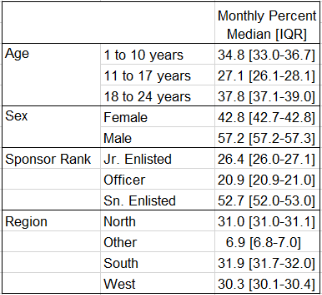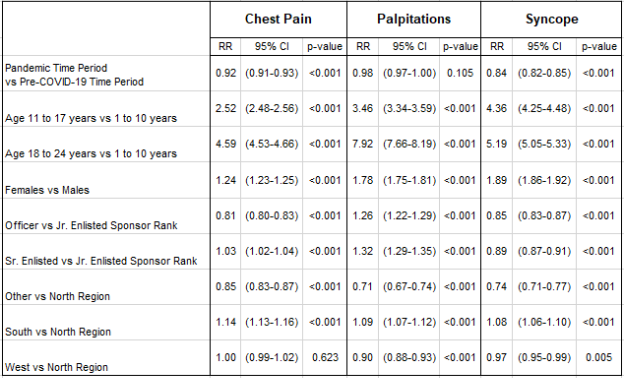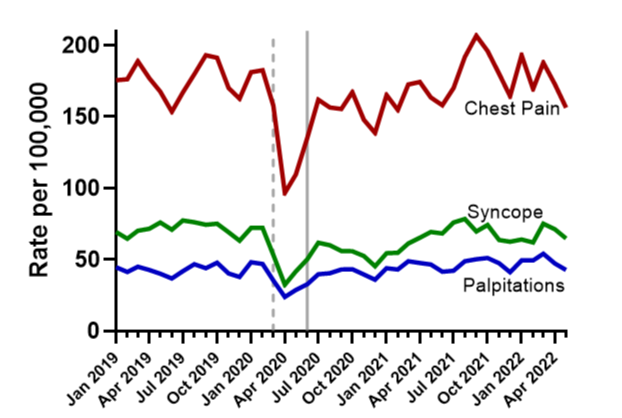Cardiology
Cardiology 3
721 - Trends of Cardiac Complaints In Pediatric and Young Adult Populations During the COVID-19 Pandemic
Monday, May 1, 2023
9:30 AM - 11:30 AM ET
Poster Number: 721
Publication Number: 721.4
Publication Number: 721.4
Emily M. Ferraro, Walter Reed National Military Medical Center, Kensington, MD, United States; Madeline Dorr, Uniformed Services University of the Health Sciences F. Edward Hebert School of Medicine, Gaithersburg, MD, United States; Cade M. Nylund, Uniformed Services University of the Health Sciences F. Edward Hebert School of Medicine, Bethesda, MD, United States; Apryl Susi, Henry M. Jackson Foundation at USUHS, GWU, Bethesda, MD, United States; ELIZABETH HISLE-GORMAN, Uniformed Services University, Bethesda, MD, United States; Michael Rajnik, Uniformed Services University of the Health Sciences F. Edward Hebert School of Medicine, MOUNT AIRY, MD, United States; Brian N. Hughes, Uniformed Services University of the Health Sciences F. Edward Hebert School of Medicine, Bethesda, MD, United States

Emily M. Ferraro, MD (she/her/hers)
Resident Physician
Walter Reed National Military Medical Center
Kensington, Maryland, United States
Presenting Author(s)
Background: The COVID-19 pandemic had a significant impact on the physical and mental health of children and young adults. Most current cardiac literature has focused on describing myocarditis and Multi-Inflammatory Syndrome of Children (MIS-C) with limited studies into how the COVID-19 pandemic affected the presentation of common pediatric cardiac diagnoses
Objective: Compared to pre-pandemic, we hypothesized an increase in presentation to care during the COVID-19 pandemic for chest pain, palpitations, and syncope.
Design/Methods: We performed a retrospective monthly cross sectional study using Military Health System data to examine trends in incidence of three common cardiac diagnoses from ages 1-24 years during the COVID-19 pandemic time period (June 2020-May 2022) as compared to the pre-COVID-19 time period (January 2019-February 2020). March through May 2020 were excluded due to wide-spread clinic closures. Demographic categories are listed in Table 1. ICD-10 codes defined all conditions. Exclusion criteria included pregnancy during the study period, myocarditis, pericarditis, endocarditis, or cardiomyopathy diagnosis. Incidence was defined as the first diagnosis among those without a previous diagnosis in the previous 12 months. Rates per 100,000 individuals a month and incidence rate ratios by COVID-19 time period were calculated using Poisson regression analysis.
Results: The study included an average of 2.7 million individuals per month. For the full study group, the rate of incident chest pain (RR=0.92) and syncope (RR=0.84) decreased while palpitations (RR=0.98) did not significantly change during the COVID-19 time period compared to the pre-COVID-19 period (Figure 1). Demographic characteristics and associated outcomes are listed in Table 1 and Table 2. Across both time periods, the 1-10 year age group had the lowest incidence of cardiac symptoms among all age groups. Females had higher incidence than males for all three cardiac symptoms. Those with officer rank had a statistically significant decrease in chest pain and syncope compared to those with junior enlisted rank (RR=0.81).
Conclusion(s): There was no significant increase in select cardiac complaints and presentation to care during the COVID-19 pandemic period in children and young adults. The difference in presentation of chest pain and syncope between military individuals and sponsor ranks may be influenced by socioeconomic status and warrants further investigation. Our results could be influenced by decreased participation in sports and activities which often precipitate the symptoms examined in this study.



